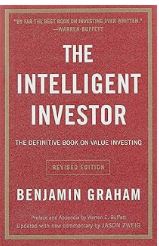 Click on the book to buy on Amazon
Click on the book to buy on Amazon
"The Intelligent Investor" by Benjamin Graham is a timeless classic
in the realm of value investing, offering profound insights into the
principles of sound investment and financial security. Graham's
approach emphasizes a disciplined, long-term strategy focused on
minimizing risk and maximizing returns. Here's a detailed summary of
the key concepts and chapters:
Introduction: The Philosophy of
Value Investing
Graham introduces the concept of value investing, which involves
buying securities when they are undervalued relative to their
intrinsic worth. He contrasts this approach with speculation, which
involves buying and selling based on short-term market fluctuations.
Part 1: Investment versus Speculation
Chapter 1: Investment versus Speculation: Results to Be Expected
by the Intelligent Investor
Graham discusses the fundamental differences between investment
and speculation. He emphasizes the importance of adopting an
investment mindset focused on long-term value, rather than trying to
time the market or chase short-term gains.
Chapter 2: The Investor and Inflation
In this chapter, Graham explores the impact of inflation on
investment returns and purchasing power. He discusses strategies for
protecting against the eroding effects of inflation, such as
investing in inflation-resistant assets like stocks and real estate.
Chapter 3: A Century of Stock Market History: The Level of Stock
Prices in Early 1972
Graham analyzes a century of stock market history to glean
insights into market trends and valuations. He cautions against
extrapolating short-term market movements into long-term investment
strategies and emphasizes the importance of a disciplined,
value-focused approach.
Part 2: The Investor's Operation Manual
Chapter 4: General Portfolio Policy: The Defensive Investor
Graham outlines his approach to portfolio management for the
defensive investor, who prioritizes capital preservation and income
stability. He discusses the importance of diversification, asset
allocation, and risk management in constructing a resilient
investment portfolio.
Chapter 5: The Defensive Investor and Common Stocks
In this chapter, Graham discusses the role of common stocks in
the defensive investor's portfolio. He provides guidelines for
selecting individual stocks, such as focusing on companies with
strong balance sheets, stable earnings, and reasonable valuations.
Chapter 6: Portfolio Policy for the Enterprising Investor:
Negative Approach
Graham presents a portfolio strategy tailored to the enterprising
investor, who is willing to take on more risk in pursuit of higher
returns. He discusses the importance of conducting thorough
research, diversifying across different asset classes, and
maintaining a margin of safety.
Chapter 7: Portfolio Policy for the Enterprising Investor: The
Positive Side
In this chapter, Graham elaborates on the positive aspects of
portfolio management for the enterprising investor. He discusses
strategies for identifying undervalued securities, such as analyzing
financial statements, assessing business fundamentals, and
estimating intrinsic value.
Part 3: The Investor and Market Fluctuations
Chapter 8: Mr. Market and His Temperament
Graham introduces the metaphor of "Mr. Market," who offers to buy
or sell stocks at varying prices based on his mood. He explains how
investors can take advantage of Mr. Market's irrational behavior by
buying when prices are low and selling when they are high.
Chapter 9: The Investor and Stock Market Fluctuations
In this chapter, Graham discusses how investors should respond to
market fluctuations and volatility. He emphasizes the importance of
maintaining a long-term perspective, staying disciplined in the face
of short-term price movements, and taking advantage of opportunities
created by market downturns.
Conclusion: The Margin of Safety
Graham concludes the book by reiterating the importance of the
margin of safety—the difference between the price of a security and
its intrinsic value. He emphasizes that successful investing
requires patience, discipline, and a focus on fundamental value,
rather than speculation or market timing.